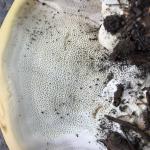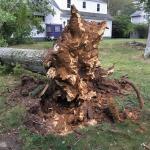Root and Butt Rot caused by Bondarzewia berkeleyi (Berkeley's Polypore)
Pathogen
The fungal pathogen Bondarzewia berkeleyi is known as Berkeley's polypore and the disease does not have a common name.
Hosts
Primarily oaks (Quercus spp.) but occasionally other deciduous hardwoods. Older literature describes B. berkeleyi from conifers as well, but the fungus is restricted to hardwoods.
Symptoms & Signs
Bondarzewia is a common and destructive pathogen of oaks in southern New England, occurring on forest and landscape trees. The fungus is also a saprophyte of dead trees or stumps left remaining in managed landscapes. Bondarzewia causes a white stringy rot of the roots and the heartwood in the lower trunk. Typically, the decay does not extend upwards in the lower trunk beyond 3–5 feet. Its growth rate is considered rapid when compared to other wood-rotting fungi common on oaks. Because the decay is mostly restricted to the heartwood, excessive tapering or flaring at the base of the trunk may be the only external symptom present. However, other symptoms may include cracks, seams and sap flow on the lower trunk. Due to its relatively fast growth rate and ability to degrade lignin as a white rot pathogen, serious reductions in structural stability can result from advanced infections. The fungus produces annual mushrooms consisting of one to five overlapping, cream-colored caps produced on a short central stem. The pore layer is white and typically does not bruise when pressed. At times, the fruiting bodies can be several feet in width, making them highly conspicuous when they appear. However, in exposed sites with dry and compacted soils, the mushrooms may be distorted and difficult to properly recognize. The mushrooms typically grow from infected roots a few feet away from the main trunk, but can also grow directly from the main trunk at the soil line. The mushrooms can appear anytime from July onward but tend to be most abundant in August. The majority of spores are dispersed locally and the risk of overland spread to other nearby oaks is likely low.
Management
While studies focused on Bondarzewia are limited, the fungus is known to primarily occupy the base of the trunk (known as the butt log) and is not known as an extensive root decayer. However, when advanced infections develop, significant portions of the primary roots can be decayed. The presence of multiple fruiting bodies around the tree often indicates an advanced infection is present. This is because wood is naturally low in nitrogen and other nutrients and significant volumes must be decayed for the fungus to produce these large fruiting bodies. Once infected trees are identified, a thorough risk assessment should be performed by a certified arborist. Nothing can be done to eradicate the pathogen and fungicides are of little, if any, value. Maintaining high tree vigor and avoiding needless basal wounding can help to avoid establishment and development of the disease.
Citations
Luley, CJ. 2022. Wood Decay Fungi Common to the Northeast & Central United States, 2nd Edition. Urban Forest Diagnostics LLC, Naples, NY. 147 p.





